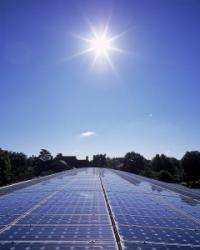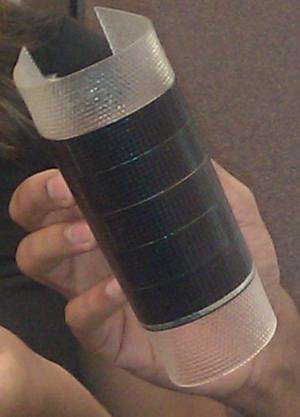Research sparks record-breaking solar cell performances

(PhysOrg.com) -- Theoretical research by scientists with the U.S. Department of Energy (DOE)’s Lawrence Berkeley National Laboratory (Berkeley Lab) has led to record-breaking sunlight-to-electricity conversion efficiencies in solar cells. The researchers showed that, contrary to conventional scientific wisdom, the key to boosting solar cell efficiency is not absorbing more photons but emitting more photons.
“A great solar cell also needs to be a great Light Emitting Diode,” says Eli Yablonovitch, the Berkeley Lab electrical engineer who led this research. “This is counter-intuitive. Why should a solar cell be emitting photons? What we demonstrated is that the better a solar cell is at emitting photons, the higher its voltage and the greater the efficiency it can produce.”
Yablonovitch holds joint appointments with Berkeley Lab’s Materials Sciences Division and the University of California (UC) Berkeley, where he is the James and Katherine Lau Chair in Engineering, and also directs the NSF Center for Energy Efficient Electronics Science. He is the corresponding author of a paper describing this work for the Journal of PhotoVoltaics titled “Intense Internal and External Fluorescence as Solar Cells Approach the Shockley-Queisser Efficiency Limit.”
Co-authoring this paper with Yablonovitch were Owen Miller of Berkeley Lab, and Sarah Kurtz, at the National Renewable Energy Laboratory.
In their paper, Yablonovitch, Miller and Kurtz describe how external fluorescence is the key to approaching the theoretical maximum efficiency at which a solar cell can convert sunlight into electricity. This theoretical efficiency, called the Shockley-Queisser efficiency limit (SQ Limit), measures approximately 33.5-percent for a single p-n junction solar cell. This means that if a solar cell collects 1,000 Watts per square meter of solar energy, the most electricity it could produce would be about 335 Watts per square meter.
Calculations by Miller, who is a member of Yablonovitch’s research group, showed that the semiconductor gallium arsenide is capable of reaching the SQ Limit. Based on this work, a private company co-founded by Yablonovitch, Alta Devices Inc., has been able to fabricate solar cells from gallium arsenide that have achieved a record conversion efficiency of 28.4 percent.

“Owen Miller provided an accurate theory on how to reach the SQ Limit that for the first time included external fluorescence efficiency,” Yablonovitch says. “His calculations for gallium arsenide showed that external fluorescence provides the voltage boost that Alta researchers subsequently observed.”
Solar or photovoltaic cells represent one of the best possible technologies for providing an absolutely clean and virtually inexhaustible source of electricity. However, for this dream to be realized, solar cells must be able to efficiently and cost-competitively convert sunlight into electricity. They must also be far less expensive to make.
The most efficient solar cells in commercial use today are made from monocrystalline silicon wafers and typically reach a conversion efficiency of about 23-percent. High grade silicon is an expensive semiconductor but is a weak collector of photons. Gallium arsenide, although even more expensive than silicon, is more proficient at absorbing photons, which means much less material is needed to make a solar cell.
“Gallium arsenide absorbs photons 10,000 times more strongly than silicon for a given thickness but is not 10,000 times more expensive,” says Yablonovitch. “Based on performance, it is the ideal material for making solar cells.”
Past efforts to boost the conversion efficiency of solar cells focused on increasing the number of photons that a cell absorbs. Absorbed sunlight in a solar cell produces electrons that must be extracted from the cell as electricity. Those electrons that are not extracted fast enough, decay and release their energy. If that energy is released as heat, it reduces the solar cell’s power output. Miller’s calculations showed that if this released energy exits the cell as external fluorescence, it would boost the cell’s output voltage.
“This is the central counter-intuitive result that permitted efficiency records to be broken,” Yablonovitch says.
As Miller explains, “In the open-circuit condition of a solar cell, electrons have no place to go so they build up in density and, ideally, emit external fluorescence that exactly balances the incoming sunlight. As an indicator of low internal optical losses, efficient external fluorescence is a necessity for approaching the SQ Limit.”
Using a single-crystal thin film technology developed earlier by Yablonovitch, called “epitaxial liftoff,” Alta Devices was able to fabricate solar cells based on gallium arsenide that not only smashed previous solar conversion efficiency records, but can be produced at well below the cost of any other solar cell technology. Alta Devices expects to have gallium arsenide solar panels on the market within a year.
“The SQ Limit is still the foundation of solar cell technology,” says Yablonovitch. “However, the physics of light extraction and external fluorescence are clearly relevant for high performance solar cells.”
Yablonovitch believes that the theoretical work by he and his co-authors, in combination with the performance demonstrations at Alta Devices, could dramatically change the future of solar cells.
“We’re going to be living in a world where solar panels are very cheap and very efficient,” Yablonovitch says.
More information: For more information about the research of Eli Yablonovitch, visit the Website at optoelectronics.eecs.berkeley.edu/
Provided by Lawrence Berkeley National Laboratory





















